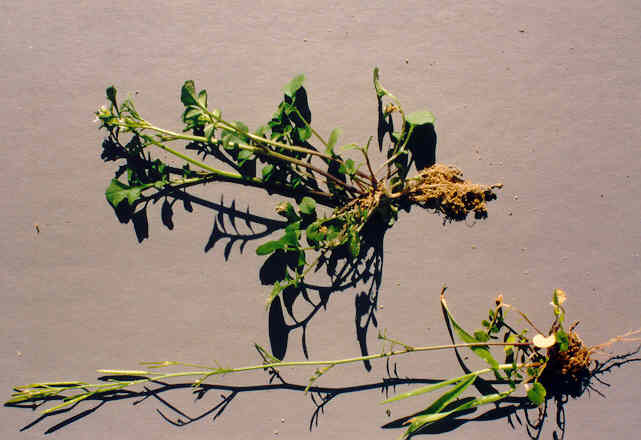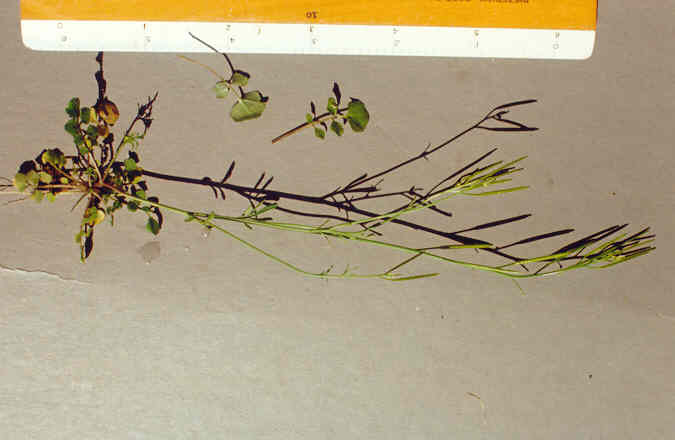
 |
Cardamine oligospermaTorrey & A. GrayBrassicaceae (Mustard Family)NativeFew-seeded Bitter-cress |
Plant Characteristics:
Annual or biennial from a slender taproot; stems glabrous to hispidulous,
1-3 dm. high; lvs. thin, with sparse white hairs on upper surface, frequently in
a basal rosette and cauline, 5-11 foliolate, 2-9 cm. long; lfts. of rosette
round to ovate, crenately 3-5 lobed, 3-9 mm. long, those of upper lvs. usually
more elongate, oblanceolate to narrow-ovate, 4-15 mm. long; raceme 2-10 fld.;
fruiting pedicels ascending to sub-erect, 3-7 mm. long; sepals ca. 1 mm. long;
petals white, ca. 2 mm. long; siliques erect, 1.2-2 cm. long, 1-1.5 mm. wide,
8-28 seeded, seeds in 1 row in each locule; style less than 1 mm. long; stigma
slightly 2-lobed; seeds winged.
Habitat:
Moist open woods or canyons, occasionally in more open places, below 3000
ft.; Chaparral, S. Oak Wd.; Yellow Pine F., etc.; Los Angeles Co. n. to B.C.
March-July.
Name: Cardamine, Greek for a cress with medicinal uses.
(Hickman, Ed. 407). Greek, oligos,
few, small, and Greek, sperma, seed.
(Jaeger 173, 243). Oligosperma,
few seeded.
General:
Common in the study area. First
found at the southerly end of the Eastbluff burn area, but later found in many
places on the easterly side of the Bay. Photographed
in the burn area. It is interesting
that I did not find this plant until February 1995 and then found it again two
days later in another spot. The
life span of this plant is relatively short and it blooms early with respect to
other Brassicaceae, which may be the reasons I have not found it sooner.
(my comments). Few people think of our California native plants as
weeds, however, a few when grown beyond their native ranges can become serious
weeds. Cardamine oligosperma is one native that has become a weed
throughout the California floristic province. (O’Brien, Bart C. “THE
INTERSECTION OF CONSERVATION AND GARDENING: AN OVERVIEW OF THE CONSEQUENCES OF
GROWING CALIFORNIA NATIVE PLANTS” FREMONTIA, A Journal of the California
Native Plant Society Vol. 29, No. 1 January 2001 pp. 16-23).
About 170 species, most of temp. parts of the world.
(Hickman, Ed. 407).
Text Ref:
Munz, Flora So. Calif. 281;
Hickman, Ed. 408; Roberts 15.
Photo Ref:
Mar 95 # 2,3; Jan-Mar 96 # 21.
Identity: by R. De Ruff, confirmed by John Johnson.
First Found: May 1995.
Computer Ref:
Plant Data 472.
Have plant specimen.
Last edit 4/8/05.
 |